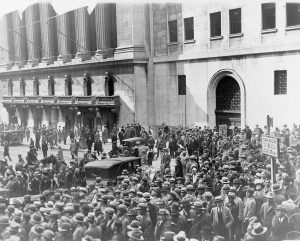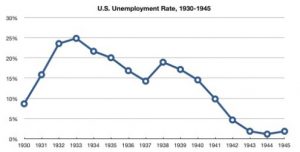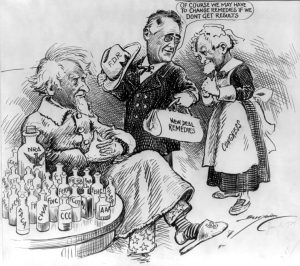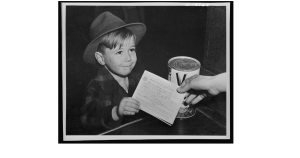Black Tuesday

A crowd of investors gather outside the New York Stock Exchange
On October 29, 1929, the United States stock market crashed in an event known as Black Tuesday. This began a chain of events that led to the Great Depression, a 10-year economic slump that affected all industrialized countries in the world. The 1920s had been a time of wealth and excess in both Europe and America, and stock prices had risen to unprecedented This encouraged many people to speculate that the market would continue to rise. Investors borrowed money to buy more stocks. As real estate values declined during the late 1920s, the stock market also weakened. When stock prices started to slide on October 29, people rushed to sell their stock and get out of the market, which drove prices down even further. This cycle led to more and more “panic selling,” until the stock market fell to its lowest point since the 19th century.
United States Census Bureau: U.S. Unemployment Rate, 1930-1945

The unemployment rate rose sharply during the Great Depression and reached its peak at the moment Franklin D. Roosevelt took office. As New Deal programs were enacted, the unemployment rate gradually lowered. Virtually full employment was achieved during World War II. This graph does not indicate the numbers of people were “underemployed,” meaning those who did not earn enough to adequately provide for themselves and their dependents.
New Deal

Cartoon of FDR providing New Deal remedies for a patient
The Great Depression made Americans question free market capitalism. President Franklin Roosevelt attempted to revive the U.S. economy by creating recovery programs and bringing about permanent social change with regulatory agencies. He promised that he would act swiftly to face the “dark realities of the moment” and assured Americans that he would “wage a war against the emergency” just as though “we were in fact invaded by a foreign foe.” His speech gave many people the confidence that they had elected a man who was not afraid to take bold steps to solve the nation’s problems. The federal government instituted a series of experimental New Deal projects and programs, such as the CCC, the WPA, the TVA, the SEC and others, that aimed to restore some measure of dignity and prosperity to many Americans. Its programs fell largely into two categories, recovery and reform. Some failed but some succeeded and became permanent. In the end, the role of the federal government changed. It became larger and more willing to regulate business and help individual citizens. The New Deal sustained the nation’s faith in capitalism.
Preparation for Point Rationing

An eager school boy gets his first experience in using war ration book two.
With the start of World War II numerous challenges confronted the American people. The government found it necessary to ration food, gas, and even clothing during that time. Americans were asked to conserve on everything. With not a single person unaffected by the war, rationing meant sacrifices for all. In the spring of 1942, the Food Rationing Program was set into motion. Rationing would deeply affect the American way of life for most. The federal government needed to control supply and demand. Rationing was introduced to avoid public anger with shortages and not to allow only the wealthy to purchase commodities. Government-sponsored ads, radio shows, posters and pamphlet campaigns urged the American people to comply. With a sense of urgency, the campaigns appealed to America to contribute by whatever means they had, without complaint. The propaganda was a highly effective tool in reaching the masses.
